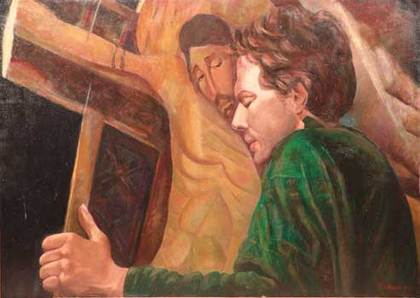Selected Memories of a Catholic Boyhood

The Real Saint Francis
There is no denying it: Saint Francis appeals to all sorts of people. Animal lovers, pacifists, environmentalists, non-Christians, secular humanists, and even atheists acknowledge that Francis — or, at least, their idea of Francis — has something to say today. Poor Saint Francis; he is more often portrayed in the middle of a birdbath than at the foot of the Cross. Francis, apart from Jesus Crucified, is completely unintelligible. A certain superficial and worldly iconography of the saint betrays the real Francis by presenting him as an amiable non-conformist; a gentle poet in love with the sun, the moon, the rain, and the earth; a magnet to birds and the tamer of a wolf.
The Embrace of Crucified Love
The world shrinks from showing us the real Francis: a man drawn into the embrace of Crucified Love and marked by Love’s own wounds; a man who went about weeping uncontrollably and saying over and over, “Love is not loved! Love is not Loved!”
The Saint With a Skull at His Feet
Francis was the first saint I came to know after Mary and Joseph. I grew up in Saint Francis of Assisi Parish in New Haven, Connecticut and, like my father and his mother before him, went to Saint Francis School. Our church’s statue of Saint Francis fascinated me. Flanked by Saint Patrick on one side of him and Saint Anthony on the other, he stood above a flaming bank of flickering red vigil lights. The statue showed him mysteriously wounded, dark eyed, with a human skull at his feet and the book of the Gospels in his pierced hands. We little boys were fascinated by the skull. It was a long time before we discovered that it wasn’t real; it was nonetheless a very convincing plaster imitation.
The Window
One of the church’s transept windows depicted Saint Francis in a blaze of jewel-like color. The window portrayed him receiving the sacred stigmata. A six-winged seraph, hovering above him, pierces his flesh with beams of fire. I loved to look at that window when the light streamed through it, carrying something of its mystery into my eyes and, through my eyes, into my heart.
The Crucifix
Saint Francis Church also had, and still has, a remarkable life size crucifix just to the left of the sacristy door. I would gravitate to it when I found myself alone in church. Was it Saint Francis who would send me to the foot of that crucifix to look into the face of Crucified Love? I know that I was not the only parishioner to linger before that crucifix. Many did. And I think that Saint Francis sent us there to experience something of the sorrow and the joy and the sweetness that filled his heart when he looked upon “the One whom they had pierced” (Jn 19:37).
A Picture Much Loved
When I was confirmed – I was ten years old, or maybe nine — my Dad gave me a beautiful framed picture of Saint Francis held fast in the arms of Jesus Crucified. How I loved that picture. It made me want to be where Francis was. Around the same time, Dad also bought me my first biography of a saint. It was a green-covered book entitled Francis of Assisi, Mirror of Christ. I still remember the author: Father Isidore O’Brien, O.F.M.
We Become What We Contemplate
Why am I sharing these memories of a Catholic boyhood? Because I believe so much in introducing children to the saints, and in providing them with holy images and with opportunities for real prayer. The course of one’s life is often shaped by such experiences.
The vocation of Saint Francis himself began with an image: the crucifix of the church of San Damiano. Speaking from that crucifix, Christ himself said, “Francis, go repair my house which, as you see, is falling into ruin.” The vocation of Saint Francis was ratified when he himself became an image of Crucified Love, an icon written by the Holy Spirit in fire and in blood.
Thomas of Celano, Saint Francis’ first biographer, writes that, “In truth there appeared in him a true image of the cross and of the passion of the Lamb without blemish who washed away the sins of the world, for seemed as though he had been recently taken down from the cross, his hands and feet were pierced as though by nails and his side wounded as though by a lance” (First Life, 112). We become what we contemplate.

Your first point reminds me of the theme of Chesterton’s biography of St. Francis. Thank you father.
Thank you for this post, Father. I have often wondered at how St. Francis’ beautiful vision of God’s creation has become divorced from his love for our Crucified Lord.
In order to have the “whole” St. Francis, we need both. Both St. Francis of the Stigmata and the San Damiano cross, and St. Francis of the Canticle of the Sun.
They don’t contradict each other when seen through Catholic eyes, with a sacramental vision of reality and understanding that Creation gets her value from her Creator, and sings out with praise to her Lord. To non-Christians, I’m sure it must be hard to fathom how one could possibly love God’s green earth and yet also bear Christ’s wounds and suffer for love of Him. To us they go hand-in-hand, as Christ suffered for the redemption of all Creation, not just man.
As a Catholic animal lover, I love the whole St. Francis~ animals, nature, and the cross and suffering.
St. Francis of Assisi, ora pro nobis!